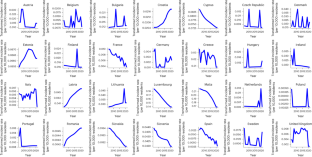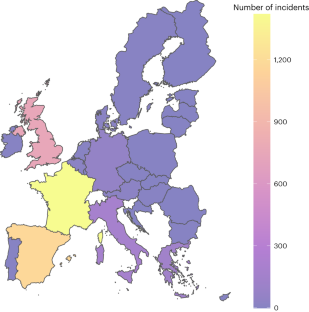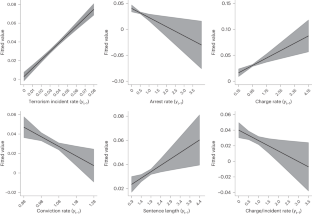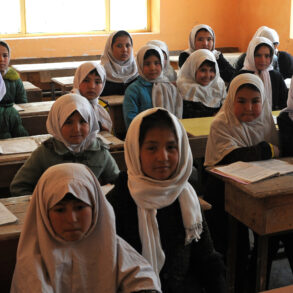Abstract
While countries differ in how they handle terrorism, criminal justice systems in Europe and elsewhere treat terrorism similar to other crime, with police, prosecutors, judges, courts and penal systems carrying out similar functions of investigations, apprehension, charging, convicting and overseeing punishments, respectively. We address a dearth of research on potential deterrent effects against terrorism by analysing data on terrorism offending, arrests, charges, convictions and sentencing over 16 years in 28 European Union member states. Applying both count and dynamic panel data models across multiple specifications, we find that increased probability of apprehension and punishment demonstrate an inverse relationship with terrorism offending, while the rate of charged individuals is associated with a small increase in terrorism. The results for sentence length are less clear but also indicate potential backlash effects. These findings unveil overlaps between crime and terrorism in terms of deterrent effects and have implications for both the research agenda and policy discussion.
This is a preview of subscription content, access via your institution
Access options
Access Nature and 54 other Nature Portfolio journals
Get Nature+, our best-value online-access subscription
$29.99 / 30 days
cancel any time
Subscribe to this journal
Receive 12 digital issues and online access to articles
$119.00 per year
only $9.92 per issue
Rent or buy this article
Prices vary by article type
from$1.95
to$39.95
Prices may be subject to local taxes which are calculated during checkout













Data availability
The datasets generated and/or analysed during the current study are available at https://doi.org/10.5281/zenodo.8196717.
Code availability
The syntax used to produce the analysis during the current study is available at https://doi.org/10.5281/zenodo.8196717.
References
-
LaFree, G., Weerman, F. & Bijleveld, C. Editor’s introduction: terrorism and violent extremism. J. Quant. Criminol. 36, 399–405 (2020).
-
Sageman, M. The stagnation in terrorism research. Terror. Polit. Violence 26, 565–580 (2014).
-
Wolfowicz, M., Litmanovitz, Y., Weisburd, D. & Hasisi, B. Cognitive and behavioral radicalization: a systematic review of the putative risk and protective factors. Campbell Syst. Rev. 17, e1174 (2021).
-
Behlendorf, B., LaFree, G. & Legault, R. Microcycles of violence: evidence from terrorist attacks by ETA and the FMLN. J. Quant. Criminol. 28, 49–75 (2012).
-
Hasisi, B., Perry, S., Ilan, Y. & Wolfowicz, M. Concentrated and close to home: the spatial clustering and distance decay of lone terrorist vehicular attacks. J. Quant. Criminol. 36, 607–645 (2020).
-
Perry, S. The application of the ‘law of crime concentration’ to terrorism: the Jerusalem case study. J. Quant. Criminol. 36, 583–605 (2020).
-
Marchment, Z., Gill, P. & Morrison, J. Risk factors for violent dissident republican incidents in Belfast: a comparison of bombings and bomb hoaxes. J. Quant. Criminol. 36, 647–666 (2020).
-
Hasisi, B., Carmel, T., Weisburd, D. & Wolfowicz, M. Crime and terror: examining criminal risk factors for terrorist recidivism. J. Quant. Criminol. 36, 449–472 (2020).
-
Marchment, Z. & Gill, P. Spatial decision making of terrorist target selection: introducing the TRACK framework. Stud. Confl. Terror. 45, 862–880 (2022).
-
Johnson, N. F. et al. Simple mathematical law benchmarks human confrontations. Sci. Rep. 3, 1–6 (2013).
-
LaFree, G., Dugan, L. & Korte, R. The impact of British counterterrorist strategies on political violence in Northern Ireland: comparing deterrence and backlash models. Criminology 47, 17–45 (2009).
-
Perry, S. & Hasisi, B. Rational choice rewards and the jihadist suicide bomber. Terror. Polit. Violence 27, 53–80 (2015).
-
Clarke, R. V. & Newman, G. R. Outsmarting the Terrorists (Praeger Security International, 2006).
-
Dugan, L., LaFree, G. & Piquero, A. R. Testing a rational choice model of airline hijackings. Criminology 43, 1031–1065 (2005).
-
Freilich, J. D., Gruenewald, J. & Mandala, M. Situational crime prevention and terrorism: an assessment of 10 years of research. Crim. Justice Policy Rev. 30, 1283–1311 (2019).
-
Newman, G. R. & Hsu, H. Y. in Countering Terrorism: Psychosocial Strategies (eds Kumar, U. & Mandal, M. K.) 227–249 (Sage, 2012).
-
Morris, N. A. & LaFree, G. in The Handbook of the Criminology of Terrorism (eds LaFree, G. & Freilich, J. D.) 93–117 (John Wiley & Sons, 2016).
-
Gassebner, M. & Luechinger, S. Lock, stock, and barrel: a comprehensive assessment of the determinants of terror. Public Choice 149, 235–261 (2011).
-
LaFree, G. & Schwarzenbach, A. Micro and macro-level risk factors for extremism and terrorism: toward a criminology of extremist violence. Monatsschr. Kriminol. 104, 184–202 (2021).
-
Hasisi, B., Perry, S. & Wolfowicz, M. in Oxford Research Encyclopedia of Criminology and Criminal Justice (eds Erez, E. & Ibarra, P.) (Oxford Univ. Press, 2020).
-
Onat, I. & San, S. in From Territorial Defeat to Global ISIS: Lessons Learned (eds Goldstone, J. A. et al.) 178–192 (IOS, 2021).
-
Lynch, J. P. in Criminologists on Terrorism and Homeland Security (eds Forst, B., Greene, J. R. & Lynch, J. P.) 151–182 (Cambridge Univ. Press, 2011).
-
Becker, G. Crime and punishment: an economic approach. J. Polit. Econ. 75, 169–217 (1968).
-
Ehrlich, I. Deterrence: evidence and inference. Yale Law J. 85, 209–227 (1975).
-
Apel, R. & Nagin, D. S. in Crime and Public Policy (eds Wilson, J. Q. & Petersilia, J.) 411–436 (Oxford Univ. Press, 2011).
-
Durlauf, S. N. & Nagin, D. S. Imprisonment and crime: can both be reduced? Criminol. Public Policy 10, 13–54 (2011).
-
Nagin, D. S. Deterrence: a review of the evidence by a criminologist for economists. Annu. Rev. Econ. 5, 83–105 (2013).
-
Nagin, D. S. Deterrence in the twenty-first century. Crime Justice 42, 199–263 (2013).
-
Pratt, T. C., Cullen, F. T., Blevins, K. R., Daigle, L. E. & Madensen, T. D. in Taking Stock (eds Cullen, F. T., Wright, J. P. & Blevins, K. R.) 367–395 (Routledge, 2017).
-
Harding, D. J., Morenoff, J. D., Nguyen, A. P., Bushway, S. D. & Binswanger, I. A. A natural experiment study of the effects of imprisonment on violence in the community. Nat. Hum. Behav. 3, 671–677 (2019).
-
Mendes, S. M. & McDonald, M. D. Putting severity of punishment back in the deterrence package. Policy Stud. J. 29, 588–610 (2001).
-
Bun, M. J., Kelaher, R., Sarafidis, V. & Weatherburn, D. Crime, deterrence and punishment revisited. Empir. Econ. 59, 2303–2333 (2020).
-
Andenaes, J. General prevention revisited: research and policy implications. J. Crim. Law Criminol. 66, 338–365 (1975).
-
Cook, P. J. & Khmilevska, N. Cross-national patterns in crime rates. Crime Justice 33, 331–345 (2005).
-
Pare, P. P. Indicators of police performance and their relationships with homicide rates across 77 nations. Int. Crim. Justice Rev. 24, 254–270 (2014).
-
Nivette, A. E. Cross-national predictors of crime: a meta-analysis. Homicide Stud. 15, 103–131 (2011).
-
Mourtgos, S. M. & Adams, I. T. The effect of prosecutorial actions on deterrence: a county-level analysis. Crim. Justice Policy Rev. 31, 479–499 (2020).
-
Germani, A. R., Pergolizzi, A. & Reganati, F. Illegal trafficking and unsustainable waste management in Italy: evidence at the regional level. J. Secur. Sustain. Issues 4, 369–389 (2015).
-
Charles, K. K. & Durlauf, S. N. Pitfalls in the use of time series methods to study deterrence and capital punishment. J. Quant. Criminol. 29, 45–66 (2013).
-
Mullins, S. Parallels between crime and terrorism: a social psychological perspective. Stud. Confl. Terror. 32, 811–830 (2009).
-
Mullins, S. & Wither, J. K. Terrorism and organized crime. Connections 15, 65–82 (2016).
-
Zubrzycki, W. Similarities and differences between organized crime and terrorism. Intern. Secur. 7, 53–70 (2015).
-
LaFree, G. & Dugan, L. How does studying terrorism compare to studying crime. Terror. Counter-terror. Criminol. Perspect. 5, 53–74 (2004).
-
Miller, G. D. Terrorist decision making and the deterrence problem. Stud. Confl. Terror. 36, 132–151 (2013).
-
Ekelund, R. B. Jr, Jackson, J. D., Ressler, R. W. & Tollison, R. D. Marginal deterrence and multiple murders. South. Econ. J. 72, 521–541 (2006).
-
Carson, J. V., Dugan, L. & Yang, S. M. A comprehensive application of rational choice theory: how costs imposed by, and benefits derived from, the US federal government affect incidents perpetrated by the radical eco-movement. J. Quant. Criminol. 36, 701–724 (2020).
-
Gill, P., Marchment, Z., Corner, E. & Bouhana, N. Terrorist decision-making in the context of risk, attack planning and attack commission. Stud. Confl. Terror. 43, 145–170 (2020).
-
Perry, S., Apel, R., Newman, G. R. & Clarke, R. V. The situational prevention of terrorism: an evaluation of the Israeli West Bank barrier. J. Quant. Criminol. 33, 727–751 (2017).
-
Freilich, J. D. & LaFree, G. Criminology theory and terrorism: introduction to the special issue. Terror. Polit. Violence 27, 1–8 (2015).
-
Baez, S. et al. Outcome-oriented moral evaluation in terrorists. Nat. Hum. Behav. 1, 1–9 (2017).
-
Nivette, A. E. et al. A global analysis of the impact of COVID-19 stay-at-home restrictions on crime. Nat. Hum. Behav. 5, 868–877 (2021).
-
Ackerman, G. & Peterson, H. Terrorism and COVID-19. Perspect. Terror. 14, 59–73 (2020).
-
Basit, A. COVID-19: a challenge or opportunity for terrorist groups? J. Policing Intell. Count. Terror. 15, 263–275 (2020).
-
Marone, F. Hate in the time of coronavirus: exploring the impact of the COVID-19 pandemic on violent extremism and terrorism in the West. Secur. J. 35, 205–225 (2022).
-
Argomaniz, J. & Vidal-Diez, A. Examining deterrence and backlash effects in counter-terrorism: the case of ETA. Terror. Polit. Violence 27, 160–181 (2015).
-
Hsu, H. Y. & McDowall, D. Examining the state repression–terrorism nexus: dynamic relationships among repressive counterterrorism actions, terrorist targets, and deadly terrorist violence in Israel. Criminol. Public Policy 19, 483–514 (2020).
-
Safer-Lichtenstein, A. An explicit consideration of unintended consequences from counterterrorism policy: the case of radical eco-groups. Stud. Confl. Terror. 42, 407–428 (2019).
-
Le Vine, V. T. & Salert, B. A. Does a coercive official response deter terrorism? The case of the PLO. Terror. Polit. Violence 8, 22–49 (1996).
-
Kaplan, E. H., Mintz, A. & Mishal, S. Tactical prevention of suicide bombings in Israel. Interfaces 36, 553–561 (2006).
-
Hussain, S. E. Terrorism in Pakistan: Incident Patterns, Terrorists’ Characteristics, and the Impact of Terrorist Arrests on Terrorism (Univ. of Pennsylvania, 2010).
-
Freilich, J. D., Bejan, V., Parkin, W. S., Chermak, S. M. & Gruenewald, J. An intervention analysis of fatal far-right extremist violence within a vector-autoregressive framework. Dyn. Asymmetric Confl. 13, 143–171 (2020).
-
Hafez, M. M. Suicide Bombers in Iraq: The Strategy and Ideology of Martyrdom (US Institute of Peace Press, 2007).
-
Fisher, U. Deterrence, terrorism, and American values. Homel. Secur. Aff. 3, 1–16 (2007).
-
Gómez, A. et al. Willingness to sacrifice among convicted Islamist terrorists versus violent gang members and other criminals. Sci. Rep. 12, 1–15 (2022).
-
Gill, P., Horgan, J., Corner, E. & Silver, J. Indicators of lone actor violent events: the problems of low base rates and long observational periods. J. Threat Assess. Manage. 3, 165–173 (2016).
-
Sageman, M. The implication of terrorism’s extremely low base rate. Terror. Polit. Violence 33, 302–311 (2021).
-
Lum, C., Kennedy, L. W. & Sherley, A. Is counter-terrorism policy evidence-based? What works, what harms, and what is unknown. Psicothema 20, 35–42 (2008).
-
Allan, G., Burton, M. & Pratt, A. Terrorism in Great Britain: The Statistics (House of Commons Library, 2022).
-
Brooks, R. A. Muslim ‘homegrown’ terrorism in the United States: how serious is the threat? Int. Secur. 36, 7–47 (2011).
-
Addison, M. in Violent Politics (ed. Addison, M.) 132–144 (Palgrave Macmillan, 2002).
-
Shields, C. A., Smith, B. L. & Damphousse, K. R. in The Handbook of the Criminology of Terrorism (eds LaFree, G. & Freilich, J. D.) 495–507 (John Wiley & Sons, 2016).
-
Jetter, M. & Stadelmann, D. Terror per capita. South. Econ. J. 86, 286–304 (2019).
-
European Union Terrorism Situation and Trend Report (TE-SAT) 2007 (Europol, 2007); https://www.europol.europa.eu/cms/sites/default/files/documents/tesat2007_1.pdf
-
European Union Terrorism Situation and Trend Report (TE-SAT) 2008 (Europol, 2008); https://www.europol.europa.eu/cms/sites/default/files/documents/tesat2008_1.pdf
-
European Union Terrorism Situation and Trend Report (TE-SAT) 2009 (Europol, 2009); https://www.europol.europa.eu/cms/sites/default/files/documents/tesat2009_1.pdf
-
European Union Terrorism Situation and Trend Report (TE-SAT) 2010 (Europol, 2010); https://www.europol.europa.eu/cms/sites/default/files/documents/tesat2010_1.pdf
-
European Union Terrorism Situation and Trend Report (TE-SAT) 2011 (Europol, 2011); https://www.europol.europa.eu/cms/sites/default/files/documents/te-sat2011_0.pdf
-
European Union Terrorism Situation and Trend Report (TE-SAT) 2012 (Europol, 2012); https://www.europol.europa.eu/cms/sites/default/files/documents/te-sat2012_0.pdf
-
European Union Terrorism Situation and Trend Report (TE-SAT) 2013 (Europol, 2013); https://www.europol.europa.eu/cms/sites/default/files/documents/europol_te-sat2013_lr_0.pdf
-
European Union Terrorism Situation and Trend Report (TE-SAT) 2014 (Europol, 2014); https://www.europol.europa.eu/cms/sites/default/files/documents/europol_tsat14_web_1%20%281%29.pdf
-
European Union Terrorism Situation and Trend Report (TE-SAT) 2015 (Europol, 2015); https://www.europol.europa.eu/cms/sites/default/files/documents/p_europol_tsat15_09jun15_low-rev.pdf
-
European Union Terrorism Situation and Trend Report (TE-SAT) 2016 (Europol, 2016); https://www.europol.europa.eu/cms/sites/default/files/documents/europol_tesat_2016.pdf
-
European Union Terrorism Situation and Trend Report (TE-SAT) 2017 (Europol, 2017); https://www.europol.europa.eu/tesat/2017/
-
European Union Terrorism Situation and Trend Report (TE-SAT) 2018 (Europol, 2018); https://www.europol.europa.eu/cms/sites/default/files/documents/tesat_2018_1.pdf
-
European Union Terrorism Situation and Trend Report (TE-SAT) 2019 (Europol, 2019); https://www.europol.europa.eu/cms/sites/default/files/documents/tesat_2019_final.pdf
-
European Union Terrorism Situation and Trend Report (TE-SAT) 2020 (Europol, 2020); https://www.europol.europa.eu/cms/sites/default/files/documents/european_union_terrorism_situation_and_trend_report_te-sat_2020_0.pdf
-
European Union Terrorism Situation and Trend Report (TE-SAT) 2021 (Europol, 2021); https://www.europol.europa.eu/cms/sites/default/files/documents/tesat_2021_0.pdf
-
European Union Terrorism Situation and Trend Report (TE-SAT) 2022 (Europol, 2022); https://www.europol.europa.eu/cms/sites/default/files/documents/Tesat_Report_2022_0.pdf
-
Hegghammer, T. & Ketchley, N. Plots, attacks, and the measurement of terrorism. Preprint at SocArXiv https://osf.io/preprints/socarxiv/t72yj/ (2021).
-
Hegghammer, T. & Nesser, P. Assessing the Islamic State’s commitment to attacking the West. Perspect. Terror. 9, 14–30 (2015).
-
START Global Terrorism Database Codebook: Methodology, Inclusion Criteria, and Variables (Univ. of Maryland, 2021).
-
McCann, W. S. Who said we were terrorists? Issues with terrorism data and inclusion criteria. Stud. Confl. Terror. 46, 964–984 (2023).
-
Campedelli, G. M., Bartulovic, M. & Carley, K. M. Learning future terrorist targets through temporal meta-graphs. Sci. Rep. 11, 8533 (2021).
-
Global Terrorism Index 2022: Measuring the Impact of Terrorism (Institute for Economics and Peace, 2022).
-
World Development Indicators (2022): Population Total (World Bank, 2022); https://databank.worldbank.org/indicator/SP.POP.TOTL/1ff4a498/Popular-Indicators#
-
Dynamic Database of European Judicial Systems (2022): European Judicial Systems (European Commission for the Efficiency of Justice, 2022); https://public.tableau.com/app/profile/cepej/viz/QuantitativeDataEN/Tables?publish=yes
-
Human Development Index (HDI) (United Nations Development Programme, 2022); https://hdr.undp.org/data-center/human-development-index#/indicies/HDI
-
Park, S. Cutbacks revisited: the relationship between resources and performance. Public Manage. Rev. 21, 515–536 (2019).
-
Pratt, T. C. & Cullen, F. T. Assessing macro-level predictors and theories of crime: a meta-analysis. Crime Justice 32, 373–450 (2005).
-
Government Finance Statistics (GFS) (International Monetary Fund, 2022); https://data.imf.org/?sk=a0867067-d23c-4ebc-ad23-d3b015045405
-
Sah, R. K. Social osmosis and patterns of crime. J. Polit. Econ. 99, 1272–1295 (1991).
-
Glaeser, E. L., Sacerdote, B. & Scheinkman, J. A. Crime and social interactions. Q. J. Econ. 111, 507–548 (1996).
-
Chamlin, M. B. Crime and arrests: an autoregressive integrated moving average (ARIMA) approach. J. Quant. Criminol. 4, 247–258 (1988).
-
Duru, H., Onat, I., Akyuz, K. & Akbas, H. Microcycles of terrorist violence in Turkey: a spatio-temporal analysis of the PKK attacks. Asian J. Criminol. 16, 235–256 (2021).
-
Decker, S. H. & Kohfeld, C. W. Crimes, crime rates, arrests, and arrest ratios: implications for deterrence theory. Criminology 23, 437–450 (1985).
-
Dills, A. K., Miron, J. A. & Summers, G. in The Economics of Crime: Lessons for and from Latin America (eds Di Tella, R., Edwards, S. & Schargrodsky, E.) 269–302 (Univ. of Chicago Press, 2010).
-
Kellett, A. et al. Terrorism in Canada 1960–1989 (Public Safety Canada, 1991); https://www.publicsafety.gc.ca/lbrr/archives/hv%206433.c2%20t4%201990-eng.pdf
-
Cubukcu, S. ‘The Dark Figure’ of Terrorism: Understanding the Reporting and Non-reporting of Terrorist Events (American Univ., 2016).
-
Cubukcu, S. & Forst, B. Measuring terrorism. Homicide Stud. 22, 94–116 (2018).
-
Zimring, F. E. & Hawkins, G. What kind of drug war? Soc. Justice 18, 104–121 (1991).
-
Young, W. & Brown, M. Cross-national comparisons of imprisonment. Crime Justice 17, 1–49 (1993).
-
Tonry, M. & Farrington, D. P. Punishment and crime across space and time. Crime Justice 33, 1–39 (2005).
-
Arellano, M. & Bond, S. Some tests of specification for panel data: Monte Carlo evidence and an application to employment equations. Rev. Econ. Stud. 58, 277–297 (1991).
-
Bun, M. J. Identifying the impact of deterrence on crime: internal versus external instruments. Appl. Econ. Lett. 22, 204–208 (2015).
-
Wan, W. Y., Moffatt, S., Jones, C. & Weatherburn, D. The effect of arrest and imprisonment on crime. Crime Justice Bull. 158, 1–20 (2012).
-
Fajnzylber, P., Lederman, D. & Loayza, N. What causes violent crime? Eur. Econ. Rev. 46, 1323–1357 (2002).
-
Neumayer, E. Good policy can lower violent crime: evidence from a cross-national panel of homicide rates, 1980–97. J. Peace Res. 40, 619–640 (2003).
-
LaFree, G. & Jiang, B. Does globalization reduce personal violence? The impact of international trade on cross-national homicide rates. Soc. Forces. 102, 353–376 (2023).
-
Rivera, M. The sources of social violence in Latin America: an empirical analysis of homicide rates, 1980–2010. J. Peace Res. 53, 84–99 (2016).
-
Rosenfeld, R. & Fornango, R. The relationship between crime and stop, question, and frisk rates in New York City neighborhoods. Justice Q. 34, 931–951 (2017).
-
Burbidge, J. B., Magee, L. & Robb, A. L. Alternative transformations to handle extreme values of the dependent variable. J. Am. Stat. Assoc. 83, 123–127 (1988).
-
MacKinnon, J. G. & Magee, L. Transforming the dependent variable in regression models. Int. Econ. Rev. 31, 315–339 (1990).
-
Pence, K. M. The role of wealth transformations: an application to estimating the effect of tax incentives on saving. Contrib. Econ. Anal. Policy 5, 1–26 (2006).
-
Hansen, L. P. Large sample properties of generalized method of moments estimators. Econometrica. 50, 1029–1054 (1982).
-
Windmeijer, F. A finite sample correction for the variance of linear efficient two-step GMM estimators. J. Econ. 126, 25–51 (2005).
-
Roodman, D. How to do xtabond2: an introduction to difference and system GMM in Stata. Stata J. 9, 86–136 (2009).
-
Lai, B. ‘Draining the swamp’: an empirical examination of the production of international terrorism, 1968–1998. Confl. Manage. Peace Sci. 24, 297–310 (2007).
-
Enders, W. & Sandler, T. Distribution of transnational terrorism among countries by income class and geography after 9/11. Int. Stud. Q. 50, 367–393 (2006).
-
Mullins, C. W. & Young, J. K. Cultures of violence and acts of terror: applying a legitimation–habituation model to terrorism. Crime Delinq. 58, 28–56 (2012).
-
Piazza, J. A. Types of minority discrimination and terrorism. Confl. Manage. Peace Sci. 29, 521–546 (2012).
-
Drakos, K. & Gofas, A. In search of the average transnational terrorist attack venue. Def. Peace Econ. 17, 73–93 (2006).
-
Young, J. K. & Dugan, L. Veto players and terror. J. Peace Res. 48, 19–33 (2011).
-
Chiricos, T. G. & Waldo, G. P. Punishment and crime: an examination of some empirical evidence. Soc. Probl. 18, 200–217 (1970).
-
Pogarsky, G. & Loughran, T. A. The policy-to-perceptions link in deterrence: time to retire the clearance rate. Criminol. Public Policy 15, 777–790 (2016).
-
Tittle, C. R. Crime rates and legal sanctions. Soc. Probl. 16, 409–423 (1969).
-
Levitt, S. D. The relationship between crime reporting and police: implications for the use of uniform crime reports. J. Quant. Criminol. 14, 61–81 (1998).
-
Levitt, S. D. Why do increased arrest rates appear to reduce crime: deterrence, incapacitation, or measurement error? Econ. Inq. 36, 353–372 (1998).
-
Logan, C. H., Bailey, W. C., Gray, L. N. & Martin, J. D. On punishment and crime (Chiricos and Waldo, 1970): some methodological commentary. Soc. Probl. 19, 280–289 (1971).
-
Tittle, C. R. & Rowe, A. R. Certainty of arrest and crime rates: a further test of the deterrence hypothesis. Soc. Forces 52, 455–462 (1974).
-
Gibbs, J. P. & Firebaugh, G. The artifact issue in deterrence research. Criminology 28, 347–367 (1990).
-
Wooldridge, J. M. Econometrics: Panel Data Methods (Springer, 2009).
-
Wooldridge, J. M. Quasi-maximum likelihood estimation and testing for nonlinear models with endogenous explanatory variables. J. Econ. 182, 226–234 (2014).
-
Gourieroux, C., Monfort, A. & Trognon, A. Pseudo maximum likelihood methods: applications to Poisson models. Econometrica. 52, 701–720 (1984).
-
Correia, S., Guimarães, P. & Zylkin, T. Fast Poisson estimation with high-dimensional fixed effects. Stata J. 20, 95–115 (2020).
-
Silva, J. S. & Tenreyro, S. Further simulation evidence on the performance of the Poisson pseudo-maximum likelihood estimator. Econ. Lett. 112, 220–222 (2011).
-
Allison, P. Do we really need zero-inflated models? Statistical Horizons http://statisticalhorizons.com/zero-inflated-models (2012).
-
Fisher, W. H., Hartwell, S. W. & Deng, X. Managing inflation: on the use and potential misuse of zero-inflated count regression models. Crime Delinq. 63, 77–87 (2017).
-
Du Bois, C. & Buts, C. Military support and transnational terrorism. Def. Peace Econ. 27, 626–643 (2016).
-
Johnson, T. L., Johnson, N. N., Sabol, W. J. & Snively, D. T. Law enforcement agencies’ college education hiring requirements and racial differences in police-related fatalities. J. Police Crim. Psychol. 37, 681–698 (2022).
-
Ajide, K. B. & Alimi, O. Y. Natural resource rents, inequality, and terrorism in Africa. Def. Peace Econ. 33, 712–730 (2022).
-
Carter, D. B. & Ying, L. The gravity of transnational terrorism. J. Confl. Resolut. 65, 813–849 (2021).
-
Worrall, J. L. & Pratt, T. C. On the consequences of ignoring unobserved heterogeneity when estimating macro-level models of crime. Soc. Sci. Res. 33, 79–105 (2004).
Acknowledgements
We received partial funding through a research contract from the Canadian Network for Research on Terrorism, Security, and Society and the Institute for Futures Studies, Sweden, provided to M.W. The funders had no role in study design, data collection and analysis, decision to publish or preparation of the manuscript.
Author information
Authors and Affiliations
Contributions
M.W. and P.G. developed the concept and design of the studies. A.S. contributed to data collection, processing and performing the initial analyses. M.W. and G.M.C. carried out the analyses, produced all tables and figures, and prepared the manuscript. The development and editing of the manuscript were overseen by P.G.
Corresponding author
Ethics declarations
Competing interests
The authors declare no competing interests.
Peer review
Peer review information
Nature Human Behaviour thanks Gary LaFree and James Piazza for their contribution to the peer review of this work. Peer reviewer reports are available.
Additional information
Publisher’s note Springer Nature remains neutral with regard to jurisdictional claims in published maps and institutional affiliations.
Extended data
Supplementary information
Rights and permissions
Springer Nature or its licensor (e.g. a society or other partner) holds exclusive rights to this article under a publishing agreement with the author(s) or other rightsholder(s); author self-archiving of the accepted manuscript version of this article is solely governed by the terms of such publishing agreement and applicable law.
About this article
Cite this article
Wolfowicz, M., Campedelli, G.M., Seaward, A. et al. Arrests and convictions but not sentence length deter terrorism in 28 European Union member states.
Nat Hum Behav (2023). https://doi.org/10.1038/s41562-023-01695-6
-
Received:
-
Accepted:
-
Published:
-
DOI: https://doi.org/10.1038/s41562-023-01695-6
This post was originally published on this site be sure to check out more of their content.








